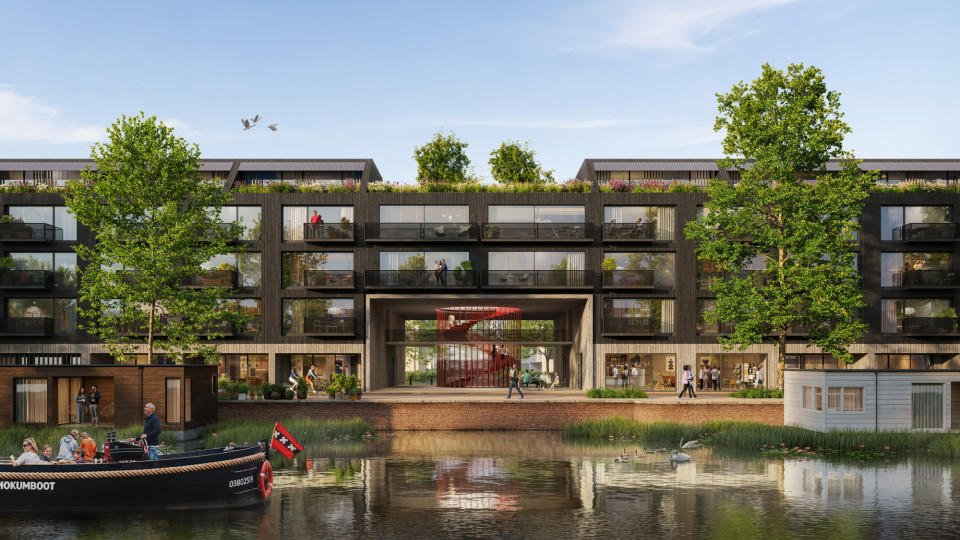Dutch start-up Tatami introduces an affordable, circular housing brand with a unique design signature that can be built quickly. With Tatami, Amsterdam founders Stan Vermeulen, Jeroen Koops, and Pepijn van de Weijer aim to rigorously accelerate and improve the process of large-scale modular housing construction.
To accelerate and guarantee quality, Tatami works with a permanent team of experts in the field of design, circular design, and development. These partners also co-invest in the brand. Paul de Ruiter Architects, which specializes in sustainable architecture, and the well-known interior design firm TANK are jointly signing on to design the circular, energy-neutral design homes. The modular homes are 90% factory-produced and cleverly assembled on construction into a unique but recognizable Tatami residential building. This process saves time, money, and CO2 emissions and guarantees high quality for each home.
Modular and sustainable design, accessible to all
The innovative architectural design allows each residential building to be easily adapted to the specific context of the site and urban planning vision. The homes can be delivered in the social, medium, and free sector and also offer a choice of different completion levels from shell to furnished with designer lease furniture. Even after delivery, Tatami remains responsible for the maintenance of the building and service to the residents.
Creator Stan Vermeulen, former CEO of the successful stroller brand Joolz: "With Tatami we want to make sustainable, affordable, and good living accessible to everyone. I am used to thinking from a brand, working with industrial designers, streamlining and automating production processes. I realized that you can also develop housing from a brand vision and with a team of top designers, create an industrially produced and sustainable residential building with a unique look and feel, which can be configured in detail just like a car or a baby carriage. In addition, I think it is essential that as a housing brand you stand for the quality you deliver and are therefore responsible for the final product and customer service." From this brand vision, the circular design housing brand Tatami was born.
Housing shortage, environmental impact, and financial return
The housing shortage in recent decades has never been as palpable as it is today. Tatami wants to contribute to solving the housing shortage while adding quality and reducing the CO2 emissions of its residential buildings to zero. The speed with which the housing shortage must be solved must not come at the expense of the architectural design, the integration within the urban planning vision, and the livability of the housing. Tatami will therefore not only develop faster and more affordably but also invest in beautiful and sustainable quality housing that is future-proof. Even after completion, Tatami remains responsible for maintenance and service, and partly for this reason the financial return can be calculated over the life of the building (Total Cost of Ownership). This approach to financial return makes it possible to invest in design, sustainability, and the quality of the homes in (the) long term.
Ever smarter. Ever more sustainable
Tatami's circular design homes were designed in close collaboration with Paul de Ruiter Architects and TANK according to the WELL Building Standard principle. The happiness, health, and well-being of the residents are central to this. The application of smart meters and blockchain technology ensures that the performance of the Tatami buildings is continuously measured, analyzed, and improved. This information is also used to further refine the design of new homes. In this way, Tatami ensures that the design home brand is becoming smarter and more sustainable.
Architect Paul de Ruiter, founder, and director of Paul de Ruiter Architects: "We design inclusive buildings that are human-centered and also energy-neutral and circular. Smart stacking and switching create interesting and recognizable residential buildings that all have their own outdoor space and are of high living quality. We can now stack up to 20 stories high."
Tommy Kleerekoper, founding partner TANK: "For Tatami, we design spatial, comfortable homes with a recognizable signature as well as room for everyone's style. Here we choose to emphasize the experience of space. With zones instead of rooms, optimal sightlines, and maximum daylight, a smart, full-fledged, personal, and recognizable home is created."
Short-term goals
Tatami focuses on positions where stacked housing can be realized from 50 to 500 homes per project, spread over 4 to 12 layers high. The goal is to start at least one development project in 2021. Several volume studies and business cases have already been developed, including the purchase of land positions and the redevelopment of an existing shopping center into a 200-unit Tatami residential building with a commercial plinth. Discussions are also underway with several developers for a joint development and land positions are being assessed through a network of brokers.
Project details
Gegevens
| Name and location | Tatami |
Ontwerpteam
| Design | Paul de Ruiter Architects and TANK interieur |
| Project architect | Paul de Ruiter and Martijn van Gameren |
| Project team | Gemlin Mohammed, Stan Vermeulen, Jeroen Koops, Pepijn van de Weijer and Bas van Gelderen |









